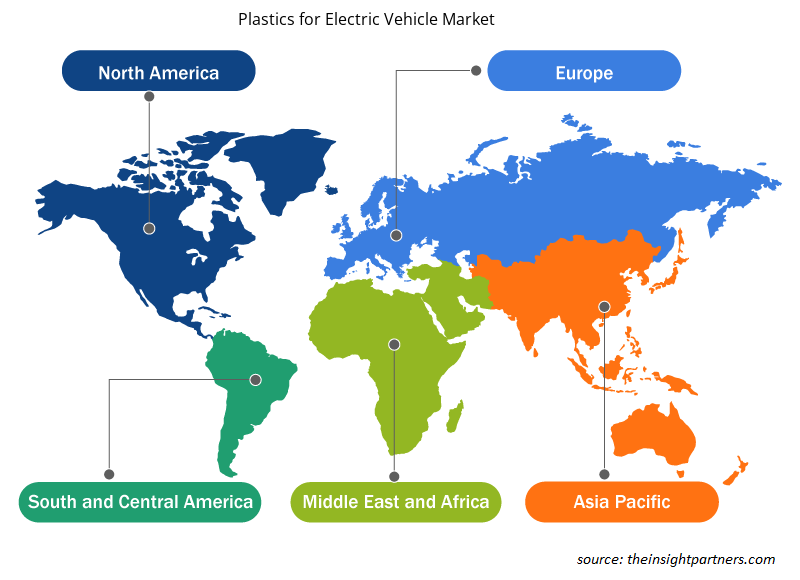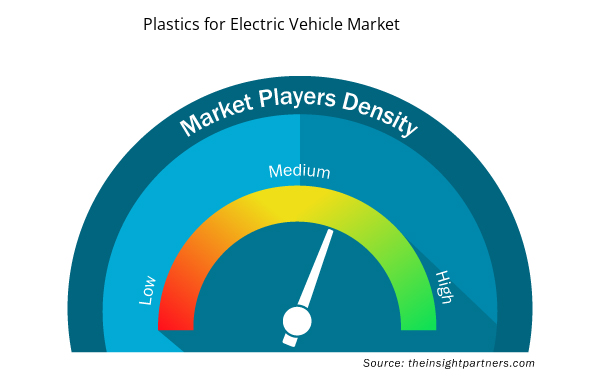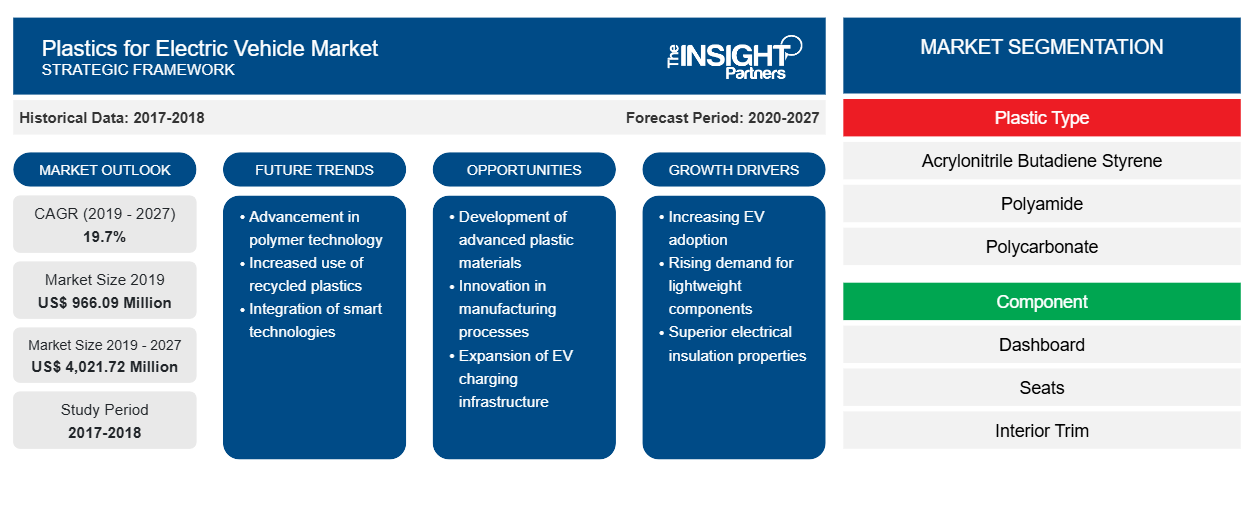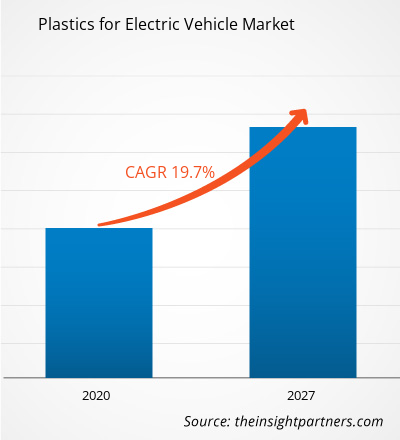電気自動車用プラスチック市場は2019年に9億6,609万米ドルと評価され、2027年までに40億2,172万米ドルに達すると予測されており、2020年から2027年にかけて19.7%のCAGRで成長すると予想されています。
プラスチックは電気導体にも絶縁体にもなります。熱可塑性ポリマーは、プラスチックの汎用性が高く成形しやすいため、電気自動車の要件に応じてさまざまな形状やデザインで製造できます。電気自動車にプラスチックを使用すると、これらの車両の重量が軽減され、充電間隔が長くなります。プラスチックは優れた耐熱性を備えているため、バッテリーコンパートメントや冷却システムの構築が可能になり、電気自動車の耐久性と安全性を損ないません。北米の電気自動車向けプラスチック市場は、 2020年から2027年にかけて20.0%という最高のCAGRで成長すると予想されています。
COVID-19パンデミックは、2019年12月に武漢(中国)で初めて報告されました。2020年6月現在、米国、ロシア、インド、スペイン、ブラジル、イタリア、フランス、ドイツは、COVID-19陽性症例数と報告された死亡者数で最も影響を受けている国の一つです。この流行は、ロックダウン、渡航禁止、事業閉鎖により、経済や産業に悪影響を及ぼしています。化学薬品と材料は、サプライチェーンの混乱、技術イベントのキャンセル、オフィス閉鎖という形で深刻な混乱に見舞われている世界の主要産業の一つです。中国は世界的な製造拠点であり、世界中のさまざまな産業にとって最大の原材料サプライヤーであると同時に、COVID-19パンデミックによる最も大きな打撃を受けた国の一つでもあります。中国のさまざまな工場の封鎖により、世界のサプライチェーン、およびさまざまな化学薬品と材料製品の製造と販売が制限されています。パンデミックの全体的な影響により、電気自動車市場向けプラスチックの成長が抑制されています。
要件に合わせてレポートをカスタマイズする
このレポートの一部、国レベルの分析、Excelデータパックなど、あらゆるレポートを無料でカスタマイズできます。また、スタートアップや大学向けのお得なオファーや割引もご利用いただけます。
- このレポートの主要な市場動向を入手してください。この無料サンプルには、市場動向から見積もりや予測に至るまでのデータ分析が含まれます。
市場分析
電気自動車の需要増加が市場の成長を牽引
自動車製造は、環境の持続可能性を重視する傾向が強まる中、温室効果ガスの排出量を減らし、燃費効率を高める方向にシフトしています。費用対効果、環境の持続可能性、利便性、先進技術の採用、優遇税率、機器購入へのインセンティブ、大幅な値引きなどのさまざまな政府政策は、世界中で電気自動車の需要を押し上げる要因の一部です。IEAによると、2019年の世界の電気自動車の販売台数は210万台で、前年比40%増を記録し、2018年を大幅に上回りました。
プラスチックタイプの洞察
プラスチックの種類に基づいて、電気自動車用プラスチック市場は、アクリロニトリルブタジエンスチレン(ABS)、ポリアミド(PA)、ポリカーボネート(PC)、ポリビニルブチラール、ポリウレタン(PU)、ポリプロピレン(PP)、その他に分類されます。ポリプロピレン(PP)セグメントは、2019年に市場で最大のシェアを占めました。ポリプロピレン(PP)は、プロピレンモノマーを組み合わせて製造される熱可塑性の「付加ポリマー」を指します。剛性があり結晶性であるため、包装トレイ、医療機器などのオブジェクトの製造に広く使用されています。ポリオレフィン樹脂の重要なファミリーの1つとして、柔軟性、強靭性、軽量性、耐熱性が求められるあらゆるプラスチックタイプに成形および押し出されます。
コンポーネントの洞察
コンポーネントに基づいて、電気自動車向けプラスチック市場は、ダッシュボード、シート、内装トリム、自動車用室内装飾品、バンパー、その他に分類されます。内装トリム部門は、2019 年に市場で最大のシェアを占めました。電気自動車の内装トリムとは、車内に存在するプラスチック部品またはパネルを指します。機能的で美しいトリムと魅力的な特徴は、完璧な車内体験を提供するために不可欠です。
車両タイプの洞察
車両タイプに基づいて、電気自動車用プラスチック市場は、BEVとPHEV/HEVに分かれています。2019年には、BEVセグメントが市場で最大のシェアを占めました。バッテリー電気自動車またはBEVは、大容量のバッテリーパックを使用して車内に電気を蓄えます。バッテリーの電力は、車内の電気モーターやその他の電子機器を動かすために使用されます。プラスチックは、電気自動車に必要な電気部品のコネクタやハウジングの製造に使用されます。
アプリケーションインサイト
用途に基づいて、電気自動車向けプラスチック市場は、パワートレインシステム/ボンネット下、外装、内装、照明および電気配線にさらに細分化されています。 内装セグメントは2019年に市場で最大のシェアを占めました。 高性能プラスチックは、安全性とセキュリティを提供する電気自動車で使用されます。 ポリプロピレンは、ガソリン缶や内装フローリングのカーペット繊維などの自動車部品によく使用されます。 PVCは、その滑らかな仕上げのため、自動車のタンクとダッシュボードに使用されます。 ステアリングホイールとダッシュボードも、アクリロニトリルブタジエンスチレンまたはABSプラスチックで製造されています。 ステアリングホイール、内装フローリング、コンソールでのプラスチックの広範な用途は、内装トリムセグメントの電気自動車向けプラスチック市場の成長に有利に働いています。
電気自動車向けプラスチック市場地域別分析
予測期間を通じて電気自動車用プラスチック市場に影響を与える地域的な傾向と要因は、Insight Partners のアナリストによって徹底的に説明されています。このセクションでは、北米、ヨーロッパ、アジア太平洋、中東、アフリカ、南米、中米にわたる電気自動車用プラスチック市場のセグメントと地理についても説明します。

- 電気自動車向けプラスチック市場の地域別データを入手
電気自動車向けプラスチック市場レポートの範囲
| レポート属性 | 詳細 |
|---|---|
| 2019年の市場規模 | 9億6,609万米ドル |
| 2027年までの市場規模 | 40億2,172万米ドル |
| 世界のCAGR(2019年 - 2027年) | 19.7% |
| 履歴データ | 2017-2018 |
| 予測期間 | 2020-2027 |
| 対象セグメント | プラスチックの種類別
|
| 対象地域と国 | 北米
|
| 市場リーダーと主要企業プロフィール |
|
電気自動車向けプラスチック市場のプレーヤー密度:ビジネスダイナミクスへの影響を理解する
電気自動車向けプラスチック市場は、消費者の嗜好の変化、技術の進歩、製品の利点に対する認識の高まりなどの要因により、エンドユーザーの需要が高まり、急速に成長しています。需要が高まるにつれて、企業は提供を拡大し、消費者のニーズを満たすために革新し、新たなトレンドを活用し、市場の成長をさらに促進しています。
市場プレーヤー密度とは、特定の市場または業界内で活動している企業または会社の分布を指します。これは、特定の市場スペースに、その規模または総市場価値と比較して、どれだけの競合相手 (市場プレーヤー) が存在するかを示します。
電気自動車向けプラスチック市場で事業を展開している主要企業は次のとおりです。
- BASF SE
- ソルベイSA
- デュポン・ド・ネムール社
- ダウ・ケミカル・カンパニー
- LG化学株式会社
免責事項:上記の企業は、特定の順序でランク付けされていません。

- 電気自動車向けプラスチック市場のトップキープレーヤーの概要を入手
レポートの注目点
- 電気自動車向けプラスチックの世界市場における進歩的な業界動向は、プレーヤーが効果的な長期戦略を策定するのに役立ちます。
- 先進国市場と発展途上国市場で採用されているビジネス成長戦略
- 2017年から2027年までの電気自動車向けプラスチック市場の定量分析
- 世界のさまざまな業界における電気自動車用プラスチックの需要予測
- 市場で活動するバイヤーとサプライヤーの有効性を示すPEST分析
- 競争的な市場シナリオと電気自動車用プラスチックの需要を理解するための最近の動向
- 市場の動向と見通し、市場の成長を牽引・抑制する要因
- 電気自動車用プラスチックの世界市場の成長を支える戦略を理解し、関係者の意思決定を支援する
- 電気自動車用プラスチックの市場規模は市場のさまざまなノードで
- 市場の詳細な概要とセグメンテーション、および業界の動向
- 電気自動車用プラスチックの世界市場規模はさまざまな地域で拡大しており、これらの地域では有望な成長機会がある
電気自動車向けプラスチック市場(プラスチックタイプ別)
- アクリロニトリルブタジエンスチレン
- ポリアミド
- ポリカーボネート
- ポリビニルブチラール
- ポリウレタン
- ポリプロピレン
- その他
電気自動車市場向けプラスチック(部品別)
- ダッシュボード
- 座席
- 内装トリム
- 車の内装
- バンパー
- その他
電気自動車向けプラスチック市場(車種別)
- 電気自動車
- ハイブリッド車
電気自動車向けプラスチック市場、用途別
- パワートレインシステム/ボンネット下
- 外観
- インテリア
- 照明と電気配線
企業プロフィール
- BASF SE
- ソルベイSA
- デュポン・ド・ネムール社
- ダウ・ケミカル・カンパニー
- LG化学株式会社
- ランクセスAG
- サビック
- コベストロAG
- 旭化成株式会社
- ライオンデルバセル インダストリーズ ホールディングス BV
- 過去2年間の分析、基準年、CAGRによる予測(7年間)
- PEST分析とSWOT分析
- 市場規模価値/数量 - 世界、地域、国
- 業界と競争環境
- Excel データセット



Report Coverage
Revenue forecast, Company Analysis, Industry landscape, Growth factors, and Trends

Segment Covered
This text is related
to segments covered.

Regional Scope
North America, Europe, Asia Pacific, Middle East & Africa, South & Central America

Country Scope
This text is related
to country scope.
よくある質問
In 2019, Asia Pacific held the largest share of the global plastics for electric vehicles market. The demand for plastics for electric vehicles is expected to increase in the region with the increase in the educated population who demand for more and more electric vehicles. The rise in disposable income and per capita consumption supports the market growth. The rising production capacities of the manufacturers of plastics favors the growth of plastics for electric vehicles market in the region. Continuous innovations in the application of plastics for electric vehicles is yet another factor driving the demand for plastics for electric vehicles. Besides these, rising awareness about the benefits of electric vehicles and initiatives taken by the Government for supporting the demand for plastics for electric vehicles, provides lucrative opportunity for the development of plastics for electric vehicles market in Asia Pacific.
The growth of polyurethane segment is primarily attributed to the fact that polyurethane (PU) is considered to be one of the most versatile plastic materials. It is formed by the reaction of polyol along with a di- isocyanate or a polymeric isocyanate in the presence of an additive or a catalyst. Polyurethane structure comprises of three complex monomers namely, diisocyanate, a macrodial and chain extender, on the basis of which many polyurethane materials can be synthesized. The polyurethane polymers are also characterized by the presence of urethane linkage. Depending on the length and nature of the hydroxyl and isocyanate molecule, the thermoplastic, hard, soft, flexible and cellular type of polyurethane is synthesized. The resultant structure resembles that of polyamide as both of them comprises of CONH groups. Polyurethane possess versatile properties like toughness, biocompatibility and durability that can be tailored depending on the application. In electronic vehicles, the engineers prefer using thermoset polyurethane adhesives for the purpose of bonding the dissimilar materials to the frame of cars. These adhesives are strong and helps in reducing the need for heavy and bulky bolts & rivets. They also help in keeping down the weight of the vehicle curb thus making the cars light & fast along with excellent charge range. Polyurethane is also used in shock absorption components in vehicles. The automakers also prefer using cast polyurethane in muffler systems. It is extensively used in electric vehicle car batteries and provide smoothest driving experience. All these factors are responsible for polyurethane segment to grow at the high rate.
The major players operating in the global plastics for electrical vehicle market are BASF SE, Solvay S.A., DuPont de Nemours, Inc., The Dow Chemical Company, LG Chem Ltd, Lanxess AG, Sabic, Covestro AG, Asahi Kasei Corporation and LyondellBasell Industries Holdings B.V.
Trends and growth analysis reports related to Chemicals and Materials : READ MORE..
The List of Companies - Global Plastics for Electric Vehicle Market
- BASF SE
- Solvay S.A.
- DuPont de Nemours, Inc.
- The Dow Chemical Company
- LG Chem Ltd
- Lanxess AG
- Sabic
- Covestro AG
- Asahi Kasei Corporation
- LyondellBasell Industries Holdings B.V
The Insight Partners performs research in 4 major stages: Data Collection & Secondary Research, Primary Research, Data Analysis and Data Triangulation & Final Review.
- Data Collection and Secondary Research:
As a market research and consulting firm operating from a decade, we have published and advised several client across the globe. First step for any study will start with an assessment of currently available data and insights from existing reports. Further, historical and current market information is collected from Investor Presentations, Annual Reports, SEC Filings, etc., and other information related to company’s performance and market positioning are gathered from Paid Databases (Factiva, Hoovers, and Reuters) and various other publications available in public domain.
Several associations trade associates, technical forums, institutes, societies and organization are accessed to gain technical as well as market related insights through their publications such as research papers, blogs and press releases related to the studies are referred to get cues about the market. Further, white papers, journals, magazines, and other news articles published in last 3 years are scrutinized and analyzed to understand the current market trends.
- Primary Research:
The primarily interview analysis comprise of data obtained from industry participants interview and answers to survey questions gathered by in-house primary team.
For primary research, interviews are conducted with industry experts/CEOs/Marketing Managers/VPs/Subject Matter Experts from both demand and supply side to get a 360-degree view of the market. The primary team conducts several interviews based on the complexity of the markets to understand the various market trends and dynamics which makes research more credible and precise.
A typical research interview fulfils the following functions:
- Provides first-hand information on the market size, market trends, growth trends, competitive landscape, and outlook
- Validates and strengthens in-house secondary research findings
- Develops the analysis team’s expertise and market understanding
Primary research involves email interactions and telephone interviews for each market, category, segment, and sub-segment across geographies. The participants who typically take part in such a process include, but are not limited to:
- Industry participants: VPs, business development managers, market intelligence managers and national sales managers
- Outside experts: Valuation experts, research analysts and key opinion leaders specializing in the electronics and semiconductor industry.
Below is the breakup of our primary respondents by company, designation, and region:

Once we receive the confirmation from primary research sources or primary respondents, we finalize the base year market estimation and forecast the data as per the macroeconomic and microeconomic factors assessed during data collection.
- Data Analysis:
Once data is validated through both secondary as well as primary respondents, we finalize the market estimations by hypothesis formulation and factor analysis at regional and country level.
- Macro-Economic Factor Analysis:
We analyse macroeconomic indicators such the gross domestic product (GDP), increase in the demand for goods and services across industries, technological advancement, regional economic growth, governmental policies, the influence of COVID-19, PEST analysis, and other aspects. This analysis aids in setting benchmarks for various nations/regions and approximating market splits. Additionally, the general trend of the aforementioned components aid in determining the market's development possibilities.
- Country Level Data:
Various factors that are especially aligned to the country are taken into account to determine the market size for a certain area and country, including the presence of vendors, such as headquarters and offices, the country's GDP, demand patterns, and industry growth. To comprehend the market dynamics for the nation, a number of growth variables, inhibitors, application areas, and current market trends are researched. The aforementioned elements aid in determining the country's overall market's growth potential.
- Company Profile:
The “Table of Contents” is formulated by listing and analyzing more than 25 - 30 companies operating in the market ecosystem across geographies. However, we profile only 10 companies as a standard practice in our syndicate reports. These 10 companies comprise leading, emerging, and regional players. Nonetheless, our analysis is not restricted to the 10 listed companies, we also analyze other companies present in the market to develop a holistic view and understand the prevailing trends. The “Company Profiles” section in the report covers key facts, business description, products & services, financial information, SWOT analysis, and key developments. The financial information presented is extracted from the annual reports and official documents of the publicly listed companies. Upon collecting the information for the sections of respective companies, we verify them via various primary sources and then compile the data in respective company profiles. The company level information helps us in deriving the base number as well as in forecasting the market size.
- Developing Base Number:
Aggregation of sales statistics (2020-2022) and macro-economic factor, and other secondary and primary research insights are utilized to arrive at base number and related market shares for 2022. The data gaps are identified in this step and relevant market data is analyzed, collected from paid primary interviews or databases. On finalizing the base year market size, forecasts are developed on the basis of macro-economic, industry and market growth factors and company level analysis.
- Data Triangulation and Final Review:
The market findings and base year market size calculations are validated from supply as well as demand side. Demand side validations are based on macro-economic factor analysis and benchmarks for respective regions and countries. In case of supply side validations, revenues of major companies are estimated (in case not available) based on industry benchmark, approximate number of employees, product portfolio, and primary interviews revenues are gathered. Further revenue from target product/service segment is assessed to avoid overshooting of market statistics. In case of heavy deviations between supply and demand side values, all thes steps are repeated to achieve synchronization.
We follow an iterative model, wherein we share our research findings with Subject Matter Experts (SME’s) and Key Opinion Leaders (KOLs) until consensus view of the market is not formulated – this model negates any drastic deviation in the opinions of experts. Only validated and universally acceptable research findings are quoted in our reports.
We have important check points that we use to validate our research findings – which we call – data triangulation, where we validate the information, we generate from secondary sources with primary interviews and then we re-validate with our internal data bases and Subject matter experts. This comprehensive model enables us to deliver high quality, reliable data in shortest possible time.


 このレポートの無料サンプルを入手する
このレポートの無料サンプルを入手する